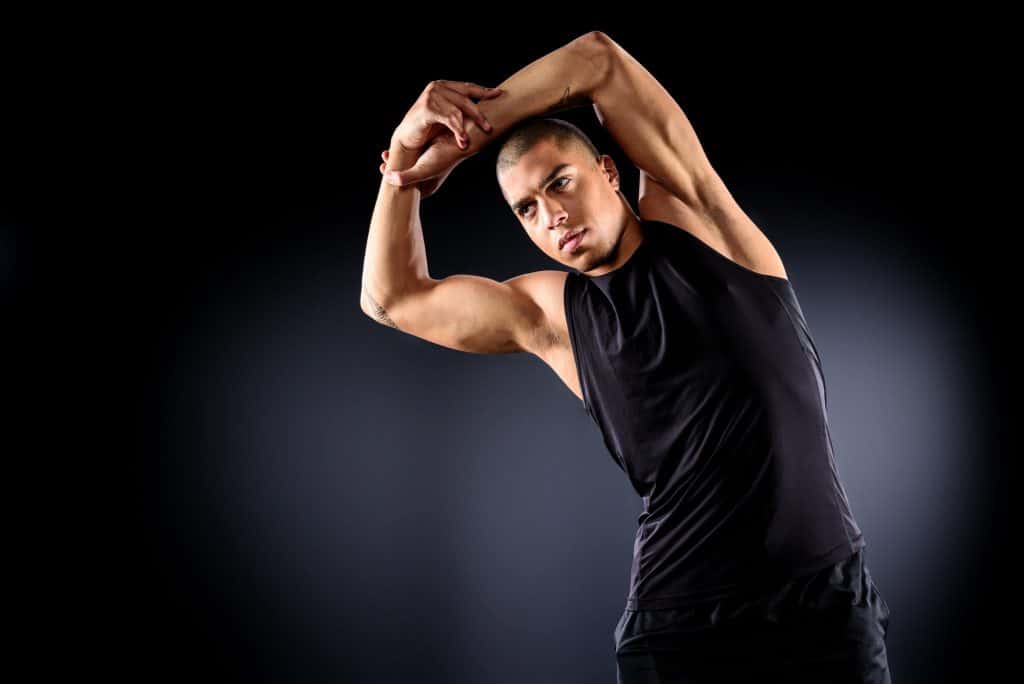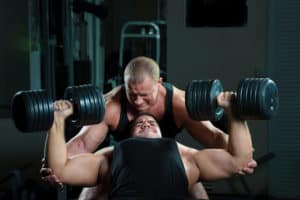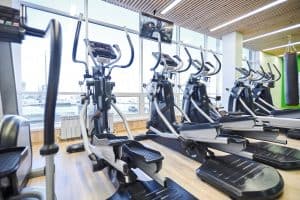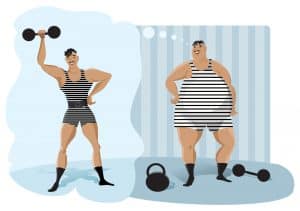After lifting weights for several months, my body started developing aches and pains.
At first, I thought it was down to my workout technique—but the real reason—I wasn’t paying attention to the way I stretch my muscles.
I’ve come to realize that it’s a crucial part of my training. What’s more, when applied strategically, muscle stretching can provide much more to my sessions.
In this article, I give you a complete muscle stretching guide.
- Table of Contents
Why You Should Stretch Your Muscles
Muscle Stretching supports the flexibility of your muscles—maintaining motion in the joints. By not stretching, your muscles will become tight. Exercising with this stiffness puts you at risk for strains and damaged joints.
The fitness benefits of stretching include:
- Increased flexibility.
- Enhanced muscular coordination.
- Better range of motion.
- Improved posture.
- Promotes body balance.
Whether you’re fitness-obsessed or not, stretching is vital for maintaining cardiovascular regulation and the automatic processes in your body—heartbeat, breathing, and digestion.
Other health benefits include:
- Decreased arterial stiffness.
- Lower blood pressure.
- Stress relief.
Stretching post-workout—will lower your heart rate and injury-proof your muscles and joints.
When Should Bodybuilders Stretch?
In an everyday scenario, research recommends muscle stretching six times per week for mobility gains. Doing simple stretches one hour after waking up will prepare your muscles for primary activity throughout the day.
In terms of fitness, we’re all fully aware that muscle stretching is a means of warming up or cooling down.
However, incorporating these techniques and the timing of when to execute them can increase the effectiveness of your training. Stretching can improve strength and muscle gains.
Concerning frequency—you should treat it as part of your workout. Every time you hit the weights, ensure the relevant muscle groups you intend on using have been adequately stretched.
I’ve detailed below, the types and the optimal time to apply them:
Muscle Stretching Pre-Workout Examples
Examples
Torso Twist - twisting your upper body from side to side while standing upright.
Leg swings - standing on one leg while swinging the other back and forth.
Muscle Stretching During Workout Examples
Eccentric or negative training focuses on lifts that lengthen the muscle after the contraction phase. It increases the time the muscle undergoes tension.
Incorporating these alternative moves into your routine will increase your range of motion. Eccentric contractions are effective for building muscle mass, plus they strengthen ligaments and tendons—preventing injuries.
Examples
Bicep curls—the downward motion.
Bench press—lowering the bar.
Pull-ups—lowering the body back to starting position.
Squat—the descent phase of the movement.
Muscle Stretching Post-Workout Examples
Static muscle stretching improves your range of motion (ROM). Doing these stretches after working out will allow your muscles to extend further—increasing their ability to grow and promoting blood flow throughout your body.
It entails stretching a muscle or muscle group to its furthermost point and holding that position for up to 30 seconds.
Examples
Overhead stretch—placing your arm behind your head then pulling on your elbow with the other hand.
Quadriceps stretch—grabbing your right foot with your right hand and pulling it back and up towards your buttocks.
A Muscle Stretching Plan
I’ve devised a pre and post-workout stretching program for a full-body workout. Remember to rest for one to two minutes between each set
Pre-Workout
1
Exercise
Sets
Reps
Jumping Jacks
1 - 2
20 - 30
Performance:
This is an all-around dynamic stretch—activating the major muscle groups and gets the blood pumping.
Stand upright—with your feet barely touching and your arms next to your sides. Jump and spread your legs at the same time, take your hands above your head. Jump back to the starting position. Repeat.
Don’t overexert yourself—the goal is to warm up, not to deplete your muscles of energy.
2
Exercise
Sets
Reps
Arm Circles
1 - 2
10-20 (each direction)
Performance:
A dynamic stretch that warms up your shoulders, biceps, triceps, and back.
Stand upright and extend your arms straight out to the side—parallel to the floor. Start making circles that are about one foot in diameter. Do this for ten seconds (one rep), then change the direction.
3
Exercise
Sets
Reps
Side Bend
1 - 2
15 - 20
Performance:
For this, you’ll need a bar. Side bends warm up your abdomen.
Stand upright with your feet shoulder-width apart. Place the bar over your head or across your shoulders and hold in position.
While keeping your upper body straight, lean to the left—don’t bend forward or backward. Hold for one to two seconds and repeat on the right—alternate sides in a continuous motion.
4
Exercise
Sets
Reps
Walking High Knees
1 - 2
10-15 (on each leg)
Performance:
A lower-body warm-up that works the glutes and hamstrings—ideal for any exercise.
Stand straight with your feet shoulder-width apart—arms by your sides. Lift your left knee to waist height. At the same time, bring your right arm forward and your left arm back. Return to starting position.
Repeat with the right leg and arms in reverse. Keep the motion continuous until you reach the number of reps.
5
Exercise
Sets
Reps
Butt Kicks
1 - 2
10-15 (on each leg)
Performance:
A lower-body warm-up that works the glutes and hamstrings—ideal for any exercise.
Stand straight with your feet shoulder-width apart—arms by your sides. Lift your left knee to waist height. At the same time, bring your right arm forward and your left arm back. Return to starting position.
Repeat with the right leg and arms in reverse. Keep the motion continuous until you reach the number of reps.
Post-Workout
1
Exercise
Sets
Reps
Hip Flexors Stretch
1 - 2
1-2 (on each leg)
Performance:
These stretches will loosen up your hip flexors and prevent injury after exercise.
Assume a kneeling position with your hands on your hips. Extend your left leg forward until your knee forms a 90-degree angle—foot should be flat and torso straight.
Hold the position for 20-30 seconds (one rep), and repeat with the other leg.
2
Exercise
Sets
Reps
Overhead Stretch
1 - 2
1-2 (each leg)
Performance:
A static stretch that focuses on your biceps, triceps, shoulders, neck, and back.
Stand upright and bring one arm overhead—your hand resting between your shoulder blades. With your free hand, grab your elbow and pull gently—you should feel it stretch.
Hold for 20-30 seconds (one rep), and repeat with the other arm.
3
Exercise
Sets
Reps
Cobra Pose
1 - 2
2 - 4
Performance:
Rebalances the abdominal muscles after working out.
Lie flat on your stomach. While keeping your lower body flat on the floor, bring your arms in, until they’re on both sides of your chest. Now, slowly bring up your chest by straightening your arms. Hold for 20-30 seconds (one rep).
4
Exercise
Sets
Reps
Reclined Pigeon
1 - 2
1-2 (each side)
Performance:
Stretches your glutes, hamstrings, and hips.
Lie on your back with your knees bent, then cross your right ankle over your left thigh. Pull your left thigh toward your chest with both hands. Hold for 30-60 seconds (one rep) and repeat with the other leg.
5
Exercise
Sets
Reps
Calves Stretch
1 - 2
2-4 (on each leg)
Performance:
Performing this static stretch after an exercise like calf raises will help the muscles repair faster and reduce injury. It also stretches the hamstrings.
Sit on the floor with both legs extended in front of you. While keeping the leg straight, reach for your left foot with your left hand.
If you can’t reach, use a resistance band to pull your toes towards your shin. Hold for 20-30 seconds (one rep) and repeat with the other leg.
The 5 Most Common Muscle Stretching Mistakes
Stretching the right way can speed up your muscle growth, but getting it wrong could lead to injury. Here are some of the most common mistakes to avoid:
1. Your Position is Wrong
Body positioning is essential to feel the full effects of any stretch. If your stance is incorrect, it’s likely you’ll miss the muscle you are aiming for.
As you perform the stretch, use your other hand to check the muscle—you should feel tightness at the beginning, but it will loosen afterward.
2. Holding Your Breath
Holding your breath will make you tense up—disabling you from relaxing while stretching. Breathing properly will keep oxygen flowing through to your muscles—detering fatigue.
3. Stretching First Thing In The Morning
The disks in your spine swell with fluids when you sleep. They slowly return to normal when you awake and assume normal activity.
Don’t do too much bending and rotating within the first hour of rising—you need to give your body some time to adjust to being upright and moving around.

4. Performing Static Stretches Before Training
Taking the static approach on muscles you’re about to train is not a good plan. This group of stretches has a sedating effect on the musculature—signaling it’s the end of your training, not the beginning.
What’s more, research backs this up. Studies confirm that static muscle stretches before exercise leads to loss of power, body strength and all-around performance.
5. Stretching Injured Muscles
Any muscle injury should be given adequate time to heal—rest it but don’t stretch it. Doing so too soon can exacerbate the issue.
Once recovered, refrain from deep muscle stretches at first—keep them light and gradually build up to the full move. If you have any concerns, consult with your doctor concerning rehabilitation.
The Takeaway
Muscle stretching is as much a priority as exercising.
Your workouts won’t be as effective if you don’t warm-up beforehand or stretch afterward. Doing this will also reduce your risk of muscle or joint injuries.
Not only does muscle stretching optimize your fitness level—it comes with a multitude of health benefits.
Everyone should be stretching the right way.













